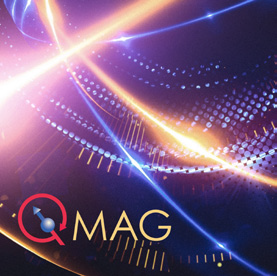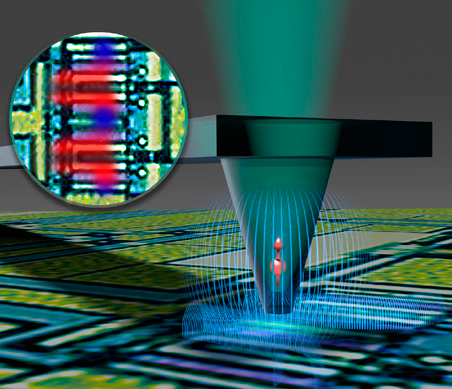Quantum sensors to measure extremely weak magnetic fields
As part of Fraunhofer’s QMag lighthouse project, quantum magnetometers for imaging very weak magnetic fields are being developed and evaluated for use, among other things, in the analysis of microelectronic and nanoelectronic circuits.


The sensor systems to be developed in the QMag lighthouse project make use of the quantized magnetic moments of individual electrons in order to use them as the smallest possible scanning magnets for the representation of magnetic field distributions with extremely high sensitivity and spatial resolution. The choice of single electron systems and the high integration of sensor components make the quantum magnetometers useful for industrial applications.
Technical challenges
The magnetic sensors currently available are only suitable for industrial use to a limited extent: in order to achieve good spatial resolution and sensitivity, the sensors must be cooled using liquid helium – this results in high operating costs and a high degree of technical complexity.
Within the scope of QMag, innovative quantum sensors suitable for industrial applications are being developed that can measure magnetic fields at room temperature with high precision and on a very small scale. The Fraunhofer Institute for Applied Solid State Physics IAF and its project partners are pursuing two technological approaches.
Measurement with nitrogen vacancy centers in diamond
With the scanning probe quantum magnetometer, an atomic defect is introduced into the nanoscale tip of a diamond crystal in a controlled manner. In this defect, a single electron is trapped. The magnetic moment of this electron is aligned and used as the smallest possible tactile magnet. This system allows the measurement of magnetic fields with highest spatial resolution even at room temperature. This makes it possible, for example, to visualize current distributions in nanoelectronic circuits.
Measurement with alkali atoms
In optically pumped magnetometers (OPMs), the magnetic moments of the outer electrons of gaseous alkali atoms are aligned. Their movement patterns then provide information about the strength of the magnetic field to be measured. At room temperature, OPMs also detect weak fields with strengths of only a few femtoteslas. This corresponds approximately to the magnetic field of human brain waves. This quantum magnetometer is suitable, among other things, for non-destructive detection of microscopic defects in material testing and for production monitoring.
In QMag, six Fraunhofer institutes are working together with two universities. The project is being funded by the Fraunhofer- Gesellschaft and the state of Baden-Württemberg equally over a period of five years.
About QMag
The core team of QMag:
• Fraunhofer Institute for Applied Solid State Physics IAF (coordination)
• Fraunhofer Institute for Physical Measurement Techniques IPM
• Fraunhofer Institute for Mechanics of Materials IWM
Also involved:
• Fraunhofer Institute for Microengineering and Microsystems IMM
• Fraunhofer Institute for Integrated Systems and Device Technology IISB
• Fraunhofer Centre for Applied Photonics CAP
Experts from the following universities are involved:
• University of Stuttgart
• University of Colorado Boulder
Last modified: